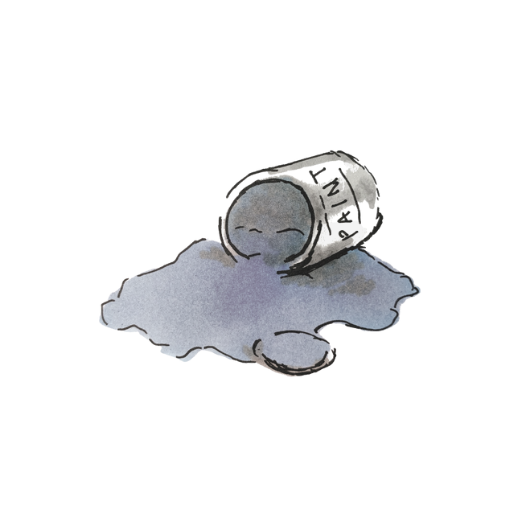
Let’s build some furniture!
I assure you that there is nothing more satisfying than making something from scratch. Well, there probably are some things more satisfying, but this is a blog about house and home, so let’s just go with it and build a DIY midcentury style side table.

Definitely a beginner’s piece, this midcentuary style side table be look equally as at home in a Marie Kondo-esque minimalist haven as it will in a wonderfully eclectic busy and bold bedroom.
For a full video tutorial, click the ‘DIY hairpin leg side table’ story highlight on my Instagram page.
You will need to make a DIY midcentury style side table
- Hairpin legs – I got mine from The Hairpin Leg Company and they come in a brilliant range of colours and sizes. For this project, you will need four 16″, 3-pin legs in raw steel. These legs come with screws.
- 18mm MDF cut to size. I got mine from B&Q and they cut it on-site for me for free. The dimensions you need are two pieces of 35x35cm and two pieces of 15x35cm. I got all mine cut from one sheet of MDF for about £12.
- Adhesive. I used B&Q’s own brand, available here. ‘No More Nails’ is another good option.
- Furniture paint. I love Rust-Oleum furniture paint, but any will work just fine. I used Rust-Oleum chalky finish in Winter Grey.
- If using a matt or chalky finish paint, you will need finishing wax. I used Rust-Oleum clear finishing wax. If you use satin finish furniture paint, then you don’t need to wax it.
- Multipurpose filler.
- Fine grade sandpaper (120 grit) and fine grade wire wool (grade 00).
- Electric drill
- Electric screwdriver (or manual if you’re super strong!)
- Screws if you need them (the legs I used came with them)
- Panel pins and hammer (optional)
How long will it take?
I set aside the best part of a Sunday to get the whole thing done, including trip to B&Q. Once you have everything you need, it will take a few hours, including drying time.
How to make a DIY midcentuary style side table
First, decide which piece of MDF will be the top panel. Mine had the barcode sticker on one piece, so this became the bottom of the unit. You’ll want to use the piece that has fewest imperfections on the top. Lay this piece face down (so that the table top is resting on the work surface) and apply adhesive to the two side edges.
Fix the side panels to the top panel according to the adhesive instructions. Wiggle them on and carefully line the edges up. Remove any overspill of adhesive – I just used my finger to wipe away the excess and fill in the gap between the two pieces of wood. Leave to dry for a little while; I left mine for about 10 minutes which was long enough for the adhesive to set.
I then painted the inside of the box, as it’s easier to do before the base panel is fixed on.
One the paint has dried, apply the base panel using adhesive and remove excess as before.
Leave the adhesive to dry. I put a heavy book on top to help it on its way. Once dry, paint the base (which is the top currently the top!)
Decide where you want to attach the hairpin legs. These are what really make the midcentury style side table look authentic. I think they look best set back a bit from the edge of the wood. You don’t see the top of the legs then, which makes the finish a bit neater. Try the legs in a few different positions. I decided to have mine set back 1.5cm from the edge.
Be sure the side facing up it to be the bottom of the box. Measure 1.5cm at each corner and draw a line to create a border all the way around.
Position the hairpin legs at the border corners and mark where the screws will go with a marker pen.
Use an appropriate drill bit to make small holes where the screws will go. Just drill in a millimetre to help the screw on it’s way.
Fix the hairpin legs to base using the screws supplied (or appropriately sized screws if your hairpin legs didn’t come with them). You can at this point hammer a panel pin into each corner and intervals between the base and side panels for a stronger hold. I didn’t do this as the table won’t be taking much weight. They aren’t required, but they will add strength if you want to go the extra mile.
Now to finish up like a pro. The box has had a first coat of paint, but it will likely be a bit rough in places. Fill any gaps and imperfections (and over any panel pins, if you’ve used them) using just a little multipurpose filler (use your fingers – it is so much easier to apply this way – get mucky!) and when it’s dried, which if applied very finely will be in a matter of minutes, sand down using fine grade sandpaper to remove any rough and uneven edges. Give the whole thing a second coat.
Once dry, I like to brush over with fine wire wool to give it a smooth finish (chalk paint only – don’t do this with satin or you’ll ruin the finish! If you are using a matt or chalky finish paint, you will need to apply furniture finishing wax to seal the paint and then buff it up.

And there you have it. A piece of furniture that you made all by yourself!
Enjoyed reading this blog? Save it for later



























